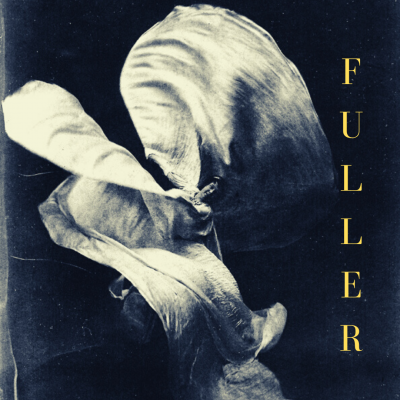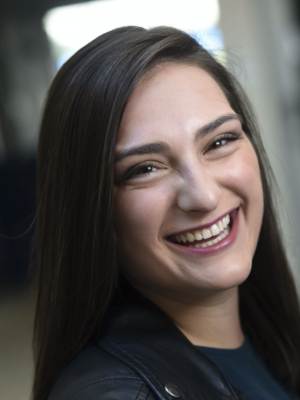The Revolutionary Art Nouveau Designer with Lessons for Theater in COVID

Loïe Fuller was a queer choreographer whose innovations with light, fabric and movement revolutionized the synthesis of art and technology in France during the early 1900s. But within a few decades of her death, she was nearly forgotten.
Inspired by her bold experiments, Artist in Residence of Theater Studies Juliana Kleist-Méndez created Fuller, a live, hybrid exploration of Loïe’s life.
Aiming to put both in-person and virtual audiences into the same space of possibility with Loïe and the performers, Kleist-Méndez uses Loïe’s embodiment of the mythical and the magical to probe changes to performance brought on by the current pandemic. What does it mean to take up space now? What does it mean to be together in space? What innovations in space are possible?
We sat down with Kleist-Méndez to discuss Loïe, Fuller and what audiences can expect when the production takes place at 7:30 p.m. on February 3, 4 and 5 at the Sheafer Lab Theater — and streamed live at the Ruby Lounge or in the comfort of your home.
How did you come across as Loïe, and what attracted you to her?
I first learned about Loïe Fuller when I was getting my master's in directing at UC San Diego. I was really drawn to the elegance of her promotional photos for Folies Bergère, which was a very famous nightclub in Paris, versus the cutting-edge innovation that she was responsible for in lighting design.
She was really fearless and brave with the way she approached the technology available to her in the theater. In a world where it was all about the big show and filling theaters with lots of bodies, she was really interested in creating a magical, transformative experience for the audience with a single body, light and fabric.
Tell us a little about her life.
She was born in the outskirts of Chicago in 1862 and from the very beginning wanted to be an actress.
She struggles in her early career, so she begins experimenting with a dance style popular at the time that uses large skirts. But she puts her own spin on it. She begins using rods. She makes the skirts longer. She has her own invention of how she assembles the silks.
As we see with TikTok choreography right now, the intellectual property of dance can be easily repeated, so Loïe had lots of imitators. Often when she gets to a theater, there would someone already there performing her choreography.
She was not having success, so she goes to France and she arrives at Folies Bergère right at the turn of this century and someone is performing the dance that she created! Eventually, she auditions and gets a spot, but she is contractually obligated to perform under the copy cat’s name.
When she finally dances under her own name, she takes Paris by storm, becoming an overnight sensation.
What she does with this success is begin to experiment even more. She hires her own crew. She has a lab in Paris where she creates 13,000 compounds for different lighting colors. Loïe becomes this massive artistic presence.
I think above all I am fascinated by this woman who comes to Paris with a dream, a passion and an energy who transforms the medium. She starts moving in circles with Marie Curie and Thomas Edison. She is one of the only women to ever have her own pavilion at the World's Fair. If any one gets curious for more, check out the scholarship of Rhonda K. Garelick on Loïe.
What do you hope to communicate about Loïe through Fuller?
We are moving through shadows of Loïe's life. I think of them as a series of explorations that might not necessarily feel linear or like a narrative. I'm hoping that this piece will be the first nugget for people to go off and get curious about finding out more detail about her life.
With Fuller, we are investigating: How do the lessons of Loïe's experience inform the ways we make theater now? What the cast, designers, and crew and I are crafting is a hybrid emotive exploration through moments of Loïe's life that are ultimately about celebrating the tools of making theater.
Audiences can expect to experience something a little different. It is at the intersection of movement, dance and theater. Fingers crossed, there are some surprises for both the at-home viewing audience and the co-located audience.
How did Loïe’s innovations inspire your own? And how will those show up in Fuller?
Loïe was always renegotiating her relationship to the tools that she had. When she was broke actress and she's asked to do an effect on stage, she didn’t have money to go out and buy a costume. So she takes a skirt and she happens to walk by a window and sees that it transforms.
I was really interested in this idea of returning to our tools. We like to think of innovation as always moving forward, forward, forward, forward, but what if we took a second to think about going backward, to revisit our tools and then going forward?
I think it's important to name that the experiments of the early 1900s set a standard of professional practice that we use today. Loïe would travel with a crew of 50-plus light operators who would help create the different effects of her piece, and at the time that was groundbreaking.
Now, we have things like automation. Rather than having a person physically move a light or change color, we can program lights to move in sync. We have fewer staff, but the range of possibilities has multiplied because we can code the lights to do certain things in this show.
It was really important to both the lighting designer, James Clotfelter, and the set designer, Mollie Singer, that we were able to see performers navigating the fundamental elements of making theater. The actors in this piece rotate between operating cameras for the live stream, moving lights and set pieces and performing. We are integrating the body — not just of the performer, but also of the operator — into the performance.
How has the pandemic influenced that approach?
For me, it was really important to create a space of experimentation, of flexibility, of adaptability. One, that's one of the things I'm interested in as a director. And two, I knew that we would have to adapt and change. For example, our first week of rehearsal had to be on Zoom because we couldn't gather in person.
The ritual of making theater is about sharing space together, which feels dangerous right now. As theater is attempting to make some steps forward, we can't forget that we're still in the middle of a pandemic.
So when I proposed this show, it was always in this hybrid form. How can we create something that can also be shared by an audience in the theater and at home?
It was exciting to think about using the live stream not just to connect a co-located and remote audience, but to connect different art centers on campus. When I was in initial conversations with Torry Bend about the piece, she mentioned how the Bryan Center [where the performance will take place] and the Rubenstein Art Center [where audiences can watch a live stream] feel like two different locations where art can happen on campus. I thought, how special to create a link between these two places — and all the other IP addresses that are going to be logging in across the country to watch the production.
This piece is being presented as part of the New Works Lab. What are your hopes for Fuller in the future?
This is not last time I'll be working with Loïe as a collaborator.
My goal here was to experiment with some ideas and forms. Particularly around what it means to make theater now. This inaugural workshop of the show will give me a sense of places to expand or deepen. If we leave the pandemic, what are the effects of performing without masks? Are there versions of this that are all virtual? What are the different locations of performance? These questions are exciting for me.
Right now, because we are in Sheafer Theater, all of the pieces of theater machinery are very accessible to us. But what happens when those pieces are less accessible? In the future, I'm interested to experiment with Fuller in different locations.
What was it like working with students on this piece?
Incredible. I have been so fortunate to work with these amazing students from a variety of different majors. Their openness of heart and willingness to explore has really informed the shape of the show.
I want to commend this cast and assistant directors because, while directing is always adaptation and directing in a pandemic is adaptation to the nth degree, it is nothing compared to being a student living through this time.
The ensemble (Alanna Manfredini, Anika Kuchukova, Asha Bashir Lopez, Joanna Brooke, Kristen Quesada, Rebecca Williamson and Matthew Norman) really have embraced Loïe and I feel very fortunate to have gotten to share her with them in the making of this piece.
Fuller takes place at 7:30 p.m. on February 3–5. Tickets are $10 to attend in person at Sheafer Lab Theater. The event will also be live streamed for free at the Ruby Lounge (no registration required) or from the device of your choice (registration required). Reserve your tickets at the Duke University Box Office.

